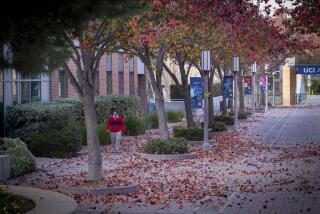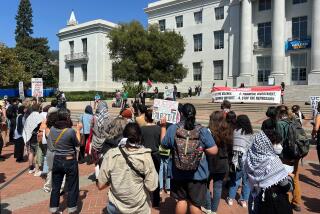UC Officials Look for Way to Save Redwood Grove : Land use: University will investigate legality of rejecting all bids on the 410 acres it has put up for sale. The move comes in response to criticism of planned transfer to timber company.
University of California officials are looking for a way to save a grove of ancient redwoods near Santa Cruz that the school tentatively agreed to sell to a timber company last week.
A UC spokesman said Thursday that university President Jack W. Peltason and Karl Pister, chancellor of the Santa Cruz campus, began discussing whether there is a way to keep the trees after an outpouring of public concern over the proposed sale.
Tom Debley, assistant director of the university’s news service, said one option under review was to reject all bids on the 410 acres the university put up for sale. But Debley said legal issues first had to be resolved. Since bids on the land already had been received, it was unclear whether state law required the university to accept the highest offer--$2.38 million from a Northern California timber company.
The proposed sale of the redwoods marked the second time in recent weeks that UC had opted to sell environmentally valuable land to ease the school’s budget crisis.
Although officials insist there is no concerted effort under way to sell environmentally sensitive property, one member of the Board of Regents has requested a report on all such land owned by the university.
“I want to know what we’ve got and why it’s valuable, so we can do a better job of protecting it,” said regent Roy Shults, a Los Angeles lawyer.
Shults became concerned after a majority of the regents voted in March to sell a 1,200-acre ranch in Sonoma County over the objections of university researchers. The researchers said the property contained a unique ecosystem that is home to more than 400 plant species and several rare freshwater invertebrates.
“About 200 members of the faculty had voted to put it in the university’s natural reserve system,” Shults said. “It is a unique ecosystem encompassing mountains, grasslands, desert and marsh land right down to the sea.”
The university’s 140,000-acre natural reserve system encompasses land around the state that is valued for research because it includes habitat or species unique to California. The university manages all the land in the reserve system but owns only about 12%.
Those reserves will grow smaller if the university ends up selling the land near Santa Cruz. According to UC officials, the property contains the largest and oldest redwoods, some of them more than 1,000 years old, in the university’s reserve system.
The Sonoma County property, known as the Button ranch for the family who donated it to the university in 1974, had been a candidate for the reserve system for about two years.
“For a long time, we didn’t know the university owned it,” said Elizabeth Riddle, assistant director of the reserve system. “Had we known, we would have expressed interest sooner than we did.”
The nearby city of Santa Rosa also had designs on the property, seeing it as a potential site for a 3-billion-gallon waste-water reservoir.
William Bagley, a regent who once represented Sonoma County in the Legislature, went to bat for Santa Rosa, recommending that the ranch be optioned to the city. Bagley, who grew up in the area, was not impressed by the property’s environmental assets.
“It’s a fallow, overgrazed, wild oats and bay tree piece of land,” said Bagley. “It’s got a canyon in it, which apparently has some interest, but to me it’s no different than any other pleasant canyon in west Sonoma County.”
But faculty members and local environmentalists objected to the sale, contending the waste-water reservoir would flood the most ecologically valuable section of the property.
Another regent, Roy Brophy of Fair Oaks, proposed the university put the property up for sale and dedicate the proceeds to student assistance. Brophy’s motion carried and the land is expected to go on the market soon.
The regents, meanwhile, insist they are not in the process of selling off the university’s natural resources as a way of meeting current financial needs.
“I would resist efforts to sell off seed corn,” Brophy said. “There are some parcels of land needed for research. I don’t think we are looking at that inventory to meet short term needs.
“But if we have land out there of no particular value for research or other uses by the university, we might take a hard look at it.”
More to Read
Sign up for Essential California
The most important California stories and recommendations in your inbox every morning.
You may occasionally receive promotional content from the Los Angeles Times.










